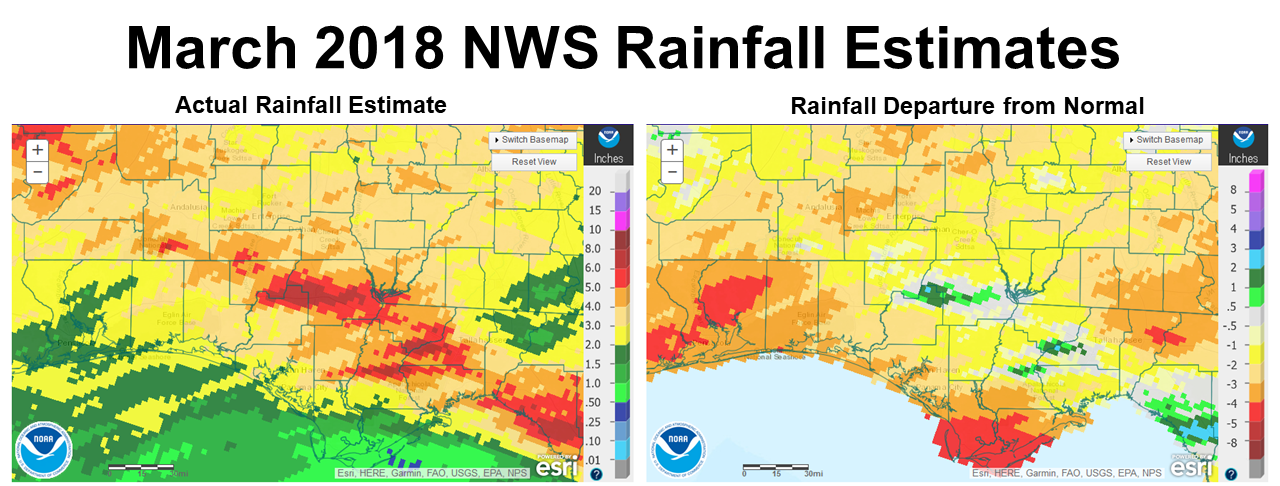
National Weather Service estimates for rainfall and departure from historic average in March 2018. Click to enlarge for easier viewing.
Rainfall
After such an unusually warm and wet month in February, temperatures were more normal in March, but the rainfall was well below normal for most of the Panhandle. The graphic above shows actual rainfall and the departure from normal for the region. From the departure from normal map on the right, you can see that only the small areas of white or green were at or above average in March.
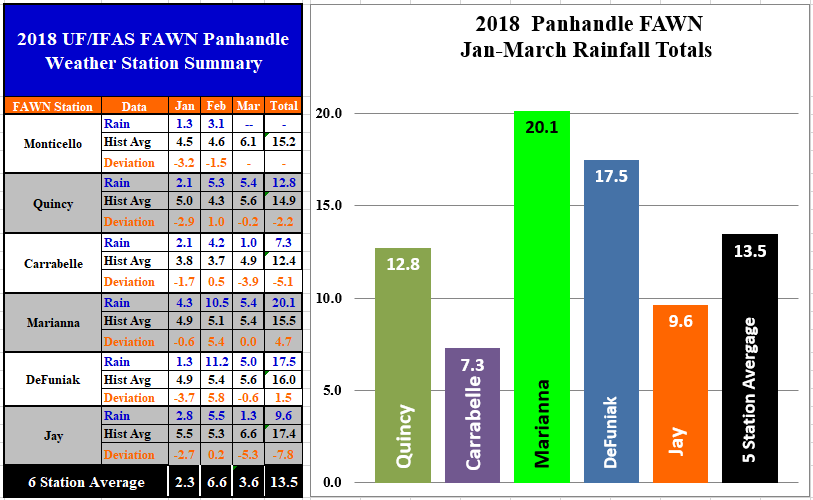 The Florida Automated Weather Network (FAWN) stations in the Panhandle also showed the considerable variation in rainfall across the region in March. The Monticello station was relocated in March, so there is no complete record for that station that month. The Marianna and Quincy stations each recorded 5.4″, while only 1.3″ was recorded in Jay, and only 1″ in Carrabelle. Only the Marianna station showed normal rainfall for the month, the others were all below historic average for March. Through the first quarter of the year, the Marianna station has recorded 20.1″, while the Carrabelle station was the dry spot with only 7.3″ Through the first three months of 2018, only the Marianna and DeFuniak locations were above average, and Jay was almost 8″ below normal.
The Florida Automated Weather Network (FAWN) stations in the Panhandle also showed the considerable variation in rainfall across the region in March. The Monticello station was relocated in March, so there is no complete record for that station that month. The Marianna and Quincy stations each recorded 5.4″, while only 1.3″ was recorded in Jay, and only 1″ in Carrabelle. Only the Marianna station showed normal rainfall for the month, the others were all below historic average for March. Through the first quarter of the year, the Marianna station has recorded 20.1″, while the Carrabelle station was the dry spot with only 7.3″ Through the first three months of 2018, only the Marianna and DeFuniak locations were above average, and Jay was almost 8″ below normal.
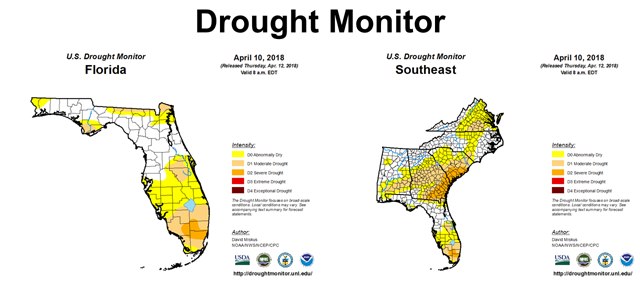 Drought is becoming a serious concern in Florida and across the Southeast. Much of the cotton and peanut belt is in the moderate or severe drought categories. You can see why the Florida Forest Service is worried about the wildfire season over the next few months; much of the region is already dry.
Drought is becoming a serious concern in Florida and across the Southeast. Much of the cotton and peanut belt is in the moderate or severe drought categories. You can see why the Florida Forest Service is worried about the wildfire season over the next few months; much of the region is already dry.
Temperatures
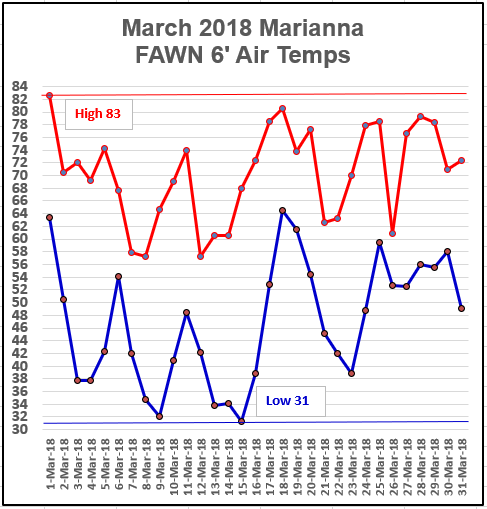 Temperatures in March cooled off some as compared to February, but the high and low temperatures were the same for both months. The high temperature in March was 83° on March 1, the low was 31° on March 15. This late freeze burnt back all of the early grass and perennial peanut growth in pastures in the region that had started greening up in early February.
Temperatures in March cooled off some as compared to February, but the high and low temperatures were the same for both months. The high temperature in March was 83° on March 1, the low was 31° on March 15. This late freeze burnt back all of the early grass and perennial peanut growth in pastures in the region that had started greening up in early February.
If you would like to see the daily temperature and rainfall summary, use the following link: 2018 1st Quarter Weather Summary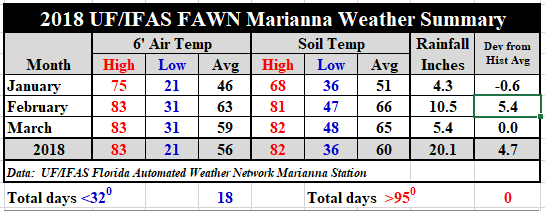 The average air temperature fell 4° down to 59°, as compared to 63° in February. The average soil temperature was 65°, which was only 1° cooler than February. Through the fist quarter of 2018 there were 18 days below freezing. In 2017 there were only 8 days below freezing, and only 10 in 2016 at the end of March. Hopefully it stayed cold long enough to reduce whitefly and other insect pest populations this year.
The average air temperature fell 4° down to 59°, as compared to 63° in February. The average soil temperature was 65°, which was only 1° cooler than February. Through the fist quarter of 2018 there were 18 days below freezing. In 2017 there were only 8 days below freezing, and only 10 in 2016 at the end of March. Hopefully it stayed cold long enough to reduce whitefly and other insect pest populations this year.
2nd Quarter Outlook
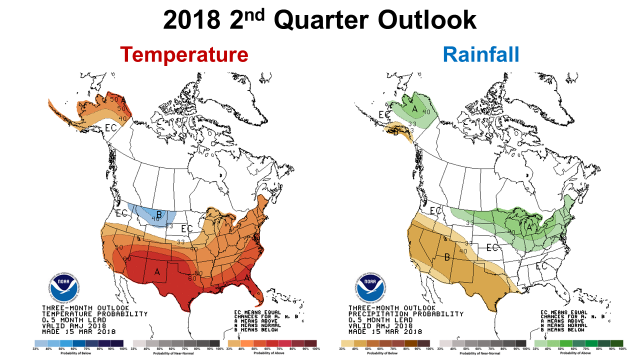 The 3-month outlook for April through June shows that the CPC expects warmer than average temperatures, but makes no forecast for rainfall variation in the Southeast.
The 3-month outlook for April through June shows that the CPC expects warmer than average temperatures, but makes no forecast for rainfall variation in the Southeast.
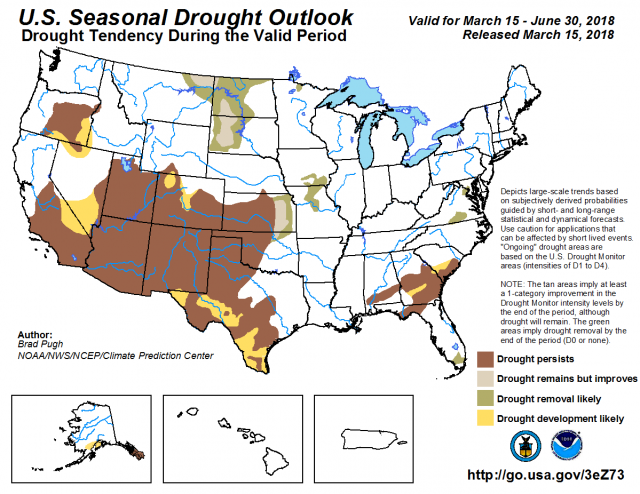 The drought outlook for the Southeast is concerning, and does not quite match the outlook above, because of the ongoing drought through the 1st quarter of 2018.. The Climate Prediction Center (CPC) is forecasting that drought will persist in portions of North Florida, South Alabama, South Georgia, and South Carolina. Hopefully La Niña will dissipate and allow for more normal neutral conditions.
The drought outlook for the Southeast is concerning, and does not quite match the outlook above, because of the ongoing drought through the 1st quarter of 2018.. The Climate Prediction Center (CPC) is forecasting that drought will persist in portions of North Florida, South Alabama, South Georgia, and South Carolina. Hopefully La Niña will dissipate and allow for more normal neutral conditions.
La Niña Watch
The CPC updated their latest ENSO forecast this week.
During March 2018, La Niña continued to weaken, but was still reflected by below-average sea surface temperatures. La Niña is expected to transition to ENSO-neutral during April-May, with ENSO-neutral then likely ( > 50% chance) to continue through the Northern Hemisphere summer 2018. Climate Prediction Center – April 12
